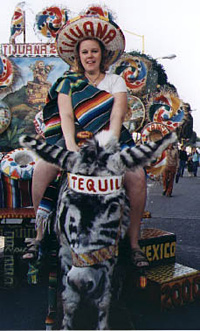
|  |  |  Travel & Outdoors | October 2008 Travel & Outdoors | October 2008  
Tijuana Doesn't Deserve Its Bad Rap
 Rick Steves - Tribune Media Services Rick Steves - Tribune Media Services
go to original


| | In much-maligned Tijuana there's much to like, finds travel writer Rick Steves. | | |
A year ago I was excited about Tangier in Morocco and wrote in my blog, "It's no longer the Tijuana of Africa." I didn't realize my comments would understandably touch a nerve with people who like Tijuana.

So recently I went to Tijuana — a Mexican town just across the U.S. border from San Diego — to give it a second look. OK, I admit, I'd never been there ... so I'd give it a first look. Working on my upcoming book on the value of travel as a political act, I also wanted to visit a rough border town where the First World meets the Developing World.

I had a great time. While Tijuana isn't a main destination town, it's fun to visit as a side trip from San Diego or a stop while heading south. And if you want to observe the cultural and economic riptides created when two worlds collide, it's a fascinating case study.

At what locals claim is the busiest international border in the world, 24 lanes are busy with traffic — 24/7. A trolley zips tourists from San Diego right to the border for $3. It also brings Mexican workers into San Diego on a daily commute that thousands make. Drivers can park within 100 yards of the border for $8 a day. Tijuana, barely a century old, thrives today with 1.5 million people. A local explained to me that there's a big funnel from Mexico to the United States, and Tijuana is the little hole through which everything flows. While there's the cross-border business — legal and illegal — there's also a thriving industry stoked by 650 maquiladoras — assembly factories for First World manufacturers, located here for the cheap labor. With plants for Samsung, Sony, and Hitachi, locals claim that more TVs are assembled here than anywhere else.

Throughout Mexico, Tijuana is considered a place of opportunity. With this thriving economy comes a thriving culture: music, arts, and an impressive cultural center. The city, while architecturally dilapidated, is extremely clean. The streets were free of litter. Locals thank their new government that "gets things done."

Tijuana's tiny old town, which radiates from the arch on Revolution Avenue, feels like a ramshackle version of the 1950s. You can't miss all the things people come to a border town for: plastic surgery, dentistry, pharmaceuticals without prescriptions, cheap haircuts, Cuban cigars, and, of course, jumping beans. The kitsch is riveting — glow-in-the-dark tattoos and hucksters hollering "Hello, 100 percent off today!" On nearly every street corner is a vendor with a donkey painted like a zebra, ready for you to don a sombrero and pose for a photo.

Bars that feel like saloons come with cheap prostitutes wearing down their stiletto heels at the doors. Apparently the siesta is alive and well, as these places rent rooms by the hour. (There are also plenty of decent places — without company for hire in the lobbies — renting $40 rooms on or near Revolution Avenue.)

After a salesman promised me that the two-hour, $10 bus tour came with a fine guided narration in English, I hopped on the bus. It was a great tour — but with no guide. I chatted the best I could with the driver. He said the United States and Mexico are brothers, stuck together. If the U.S. gets the flu, Mexico gets pneumonia.

Hopping off the bus at the cathedral, I grabbed a pew, and joined a Mass. Sitting with hundreds of Mexicans, I enjoyed a vivid reminder that the gang that tourists see along Revolution Avenue and in front of the saloons is photogenic but not representative. This was the real Tijuana. Taking an hour out of their Sundays to worship, these people — wearing hooded sweatshirts, T-shirts, and cheap shoes picked up for $3 at a street market — were the hardworking citizens of their world.

And as I that church along with all those people, and bought a bag of fresh-baked churros crusted in sugar, it occurred to me how wrong I had been about Tijuana.

Edmonds-based Rick Steves writes European travel guidebooks and hosts travel shows on public television and public radio. His syndicated column runs weekly at seattletimes.com/travel. Email him at rick(at)ricksteves.com. |

 |
|  |



